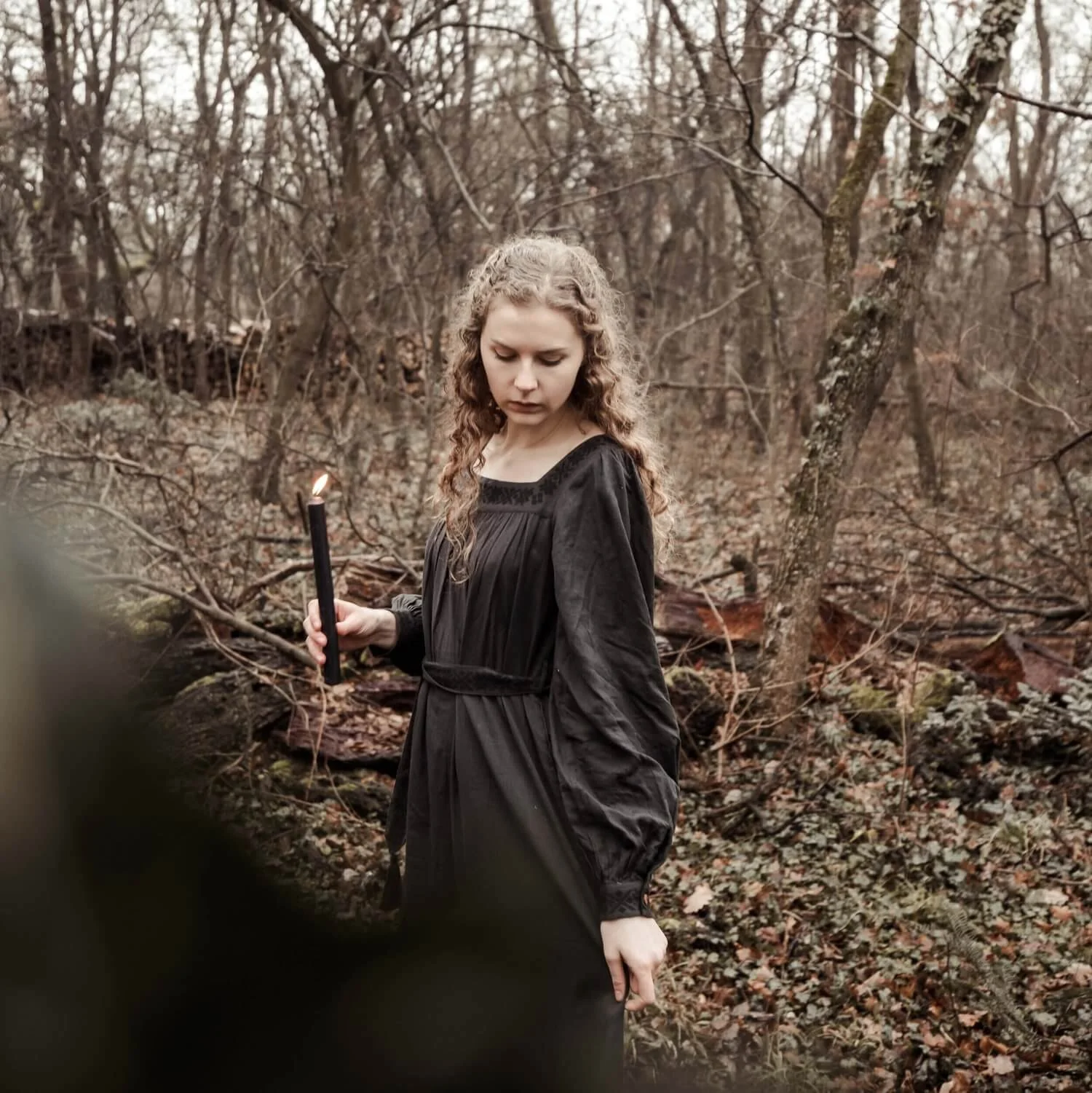The Mystical Places of the Goddess Airmed
Airmed or Airmid is the goddess of healing. She is also a goddess of Irish mythology and folklore meaning that associations with her can be found all over Ireland.
I love that gods and goddesses of ancient Celtic times are not only found in stories, but in the landscape. That's because our ancient Celtic ancestors saw spirits in the landscape. Gods and goddesses accrued a human form over time but originally, they are always an anthropomorphism of the landscape.
Airmed's Healing Wells in County Sligo, Ireland
The first location in Ireland that's connected to Airmed is Heapstown Cairn or Ochtriallach's Cairn in County Sligo, Ireland. The cairn today is a pile of stones but in the past, it was said to be Slaine's Well, where Airmed along with her alchemist brother, Miach and her father and Irish healing god, Diach Cecht, helped to heal wounded warriors.
In Irish mythology, the goddess Airmed was said to have used the water in the well to help heal the soldiers during battle. During the Second Battle of Magh Tuireadh (Cath Maige Tuired), the Irish mythology god of healing, Dian Cecht, found a strategy for healing the wounded.
He devised a plan of bringing every herb to Slaine’s Well and mixing it with the water. Then, he enlists the help of his daughter, Airmed, to chant over the water to activate its healing powers. Dian Cecht then throws the soldiers down into the well and they are healed when they reemerged.
Slaine's Well was said to have been located in Achad Abla (The Field of the Apple Tree) northwest of the battle in Magh Tuired. The legend goes that today, the well is buried under the stones, becoming Heapstown Cairn in County Sligo, Ireland.
“Dian Cecht, his two sons Octriuil and Miach, and his daughter Airmed were chanting spells over the well named Slaine. They would cast their mortally-wounded men into it as they were struck down; and they were alive when they came out. Their mortally-wounded were healed through the power of the incantation made by the four physicians who were around the well.”
Slaine's Well as a ritual goddess location
If you've read my other blog post, you'll know that it's common for goddesses to be worshipped at freshwater sites. Especially for the Celtic healing goddess Airmid, it makes sense that she would be worshipped at a site that has freshwater.
Today, Heapstown Cairn is all that marks this site so you might be wondering, how do we know for sure this is the site of the well? In the mythology, it actually tells that after the battle, the Cairn was instructed to be built.
“He suggested that every single man they had should bring a stone from the stones of the river Drowes to cast into the well Slaine in Achad Abla to the west of Mag Tuired, to the east of Lough Arrow. They went, and every man put a stone into the well. For that reason, the cairn is called Ochtriallach’s Cairn.”
Luckily, there has been some scientific investigation done to give us more clues.
The cairn is a man-made megalithic monument made of stone, so it matches up with the mythology so far. It is also in the same location as it is stated in the mythology, northwest of the battlefield. Although the cairn has not been excavated, it is believed to be a passage tomb 60 meters in diameter.
Passage tombs in Ireland were connected to particular gods and goddesses and were thought to be direct passages to the Otherworld. Ancient Irish people would go to the passages to seek guidance from the gods and goddesses that resided there.
It’s therefore not a stretch to say that ancient people would go to Heapstown Cairn to ask Airmed for cures and healing guidance.
The significance of wells in Irish mythology
Although the healing at the well is always attributed to her father, Dian Cecht, it's actually Airmed that transforms the well water into healing water in the first place. When you consider that it's goddesses that are often associated with water and healing, this makes even more sense.
Dian Cecht is the one boasting about his ability to heal with the well, but Airmed is the one that gives the well its potent curative power. She gathered and grounded the fresh herbs on the nearby plain Lusmag or herb-plain and then sung over the well. The men were then instructed to lay under the water of herbs and they would arise healed of their wounds.
The mythology points even more to Airmed being a healing goddess associated with hidden wisdom. There is a mystery to her cures, which is probably why ancient people built the Cairn and possibly a passage tomb on the site of her greatest healing victory.
Wells in Celtic mythology symbolize hidden restorative and healing powers. In Irish Celtic mythology, the goddess Brigid rules over the well as a source of poetic inspiration or Awen. In this tale, Airmed, the Celtic goddess of healing, uses the powers of the well to heal lethal wounds like decapitation, showcasing her mystical healing knowledge.
Wells full of freshwater are laden with minerals, which was why they were so sacred to ancient Celtic tribes and essentially seen as “magical”. In Irish Celtic mythology, wells were often birthplaces of the Celtic gods and goddesses, symbolizing their importance but also showing that the gods and wells were interconnected. Wells in this sense, are a portal to the gods.
The hidden meaning of Airmed's healing chants
The last part of the mythology story is Airmed's chants. In the story, she was said to chant or sing over the water in order to activate its healing properties. Although Airmed's healing knowledge is well-known, no one talks so much about her chanting ability.
Sacred chanting for healing and medicinal purposes is used in many ancient cultures however, due to lack of records and information about Celtic mythology and healing practices, it’s hard to say how the ancient Irish used this tool. From this story alone, we can see that Airmed uses chanting in the direst of circumstances, meaning that it must be one of the most powerful tools she possesses.
In Hinduism, chanting is a regular part of Ayurvedic medicine and is said to heal any and all kinds of illnesses. According to the Vedas, the mantras used to chant are cosmic sound currents that travel into each of our cells to restore balance.
Chanting helps the lungs, the circulatory system and it also helps the mind. Physically, chanting strengthens the Vagus Nerve which when stimulated helps activate the parasympathetic nervous system or the rest and digest function which helps the body heal itself.
Sound healing is also used in many eastern traditions including Hinduism and can be done either by chanting or using singing bowls. The voice or the bowls create vibrations that create balance on a cellular level within the body.
In Ayurveda, chanting has been done for over 2,000 years. In one study, scientists found that low-frequency sound waves helped blood circulation and bone metabolism in elderly patients.
Airmed in the modern day
In the mythological cycle, Airmed was revered as a Celtic healing goddess. She bravely helped soldiers recover from their "mortal wounds" by lacing water with herbs and chanting until the water gained healing properties.
In the ancient past, it isn't hard to see why Heapstown Cairn could have been a pilgrimage site for Airmed. Ancient people could have gone to the Cairn to remember the healing that day, and perhaps performed rituals and sacrifices to the goddess in the hope that she would grant their healing.
Until archaeological excavations can confirm a well at the bottom of the Cairn, it's hard to say, but one thing we do glean from the story is how Airmed was seen and the practices that may have been done. Healing chants, something not so often talked about in Celtic studies, could have been a prominent part of the culture.
As the daughter of Dian Cecht, I think Airmed still lives in his shadow. She was perhaps a more prominent goddess for healing than her father, especially given the fact that her specialty included healing herbs. Everyone in ancient times would have been calling on her for healing help, if not venerating her in their homes.
Visiting these former sites where goddesses roam is part of how we keep their memory alive.








Saint Winifred‘s mythology and history go back further than her medieval tale.